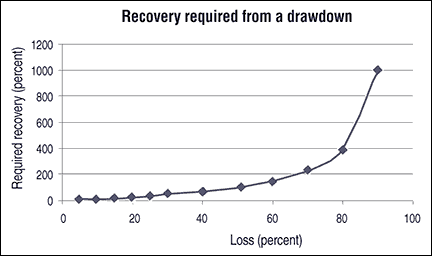MONEY MANAGEMENT
More Exit, Less Entry
Putting A Stop To It
A greater focus on your exit strategy and less on your entry may make a big difference in your overall trading results.
Investors and traders alike devote a considerable amount of time focusing on what investments to make and what tools to use to make these investments. Novices often spend very little time planning the exit strategy. This is the key difference between seasoned traders and novices. In fact, a greater focus on the exit and less on the entry might make the real difference in your overall trading effectiveness.
Why use stops?
When a loss is posted, we always measure it relative to our original holdings. A similar measure is calculated when a profit is posted. It is important to understand the asymmetry built into a loss/win cycle. Figure 1 shows that if you post a loss of 10%, it will take a percentage gain of 11.1% to recover. Okay, you can live with that as a recovery target. So what happens if you post a loss of 30%? It requires a recovery of 43% above your present net holdings to get back to your original account value. What happens if you lose 80% of your holdings? Well, that will require a 400% price move to recover your losses — not much chance of that in today’s markets. The lesson here is to cut your losses early. That is where the proficient use of stop alerts comes in.
Consistently deploying stops can be painful, but it will allow you to know the maximum limit of your loss in advance, moving you away from later stage fear–based decision-making that can occur when a trade goes against you. It’s already been decided in your trading plan; you exit with a controlled loss.

Figure 1: recovery from a drawdown. A loss of 10% will take a percentage gain of 11.1% to recover. A loss of 30% requires a recovery of 43%. A loss of 80% of your holdings requires a 400% price move to recover your losses.